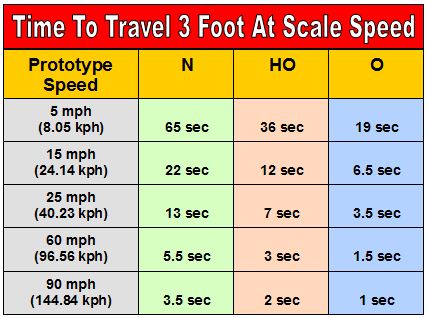Everything on model trains, model railroads, model railways, locomotives, model train layouts, scenery, wiring, DCC and more. Enjoy the world's best hobby... model railroading!
How Fast Should Trains Run?
The answer basically depends on how realistic you want your train operations to be. Obviously faster trains will have more chance of derailing especially around tight bends than slower trains; however speed is not the only reason why trains derail… but that’s another topic.
Most keen modelers will strive for realistic train speeds to better represent the true prototype operations you would see on a real life-size railroad. It’s only when we get a bit over enthusiastic (or maybe when we are still learning) that we operate our trains at unrealistic speeds.
For anyone new to operating model trains the first piece of advice would usually be to SLOW DOWN. To look real, model trains need to operate at scale speeds, not like performance racing cars.
 In HO scale (1:87) a 40ft boxcar is typically about 5.75 inches long.
In HO scale (1:87) a 40ft boxcar is typically about 5.75 inches long.
Positioning a YARD RULER alongside a straight stretch of mainline track is a good way to practice running trains at various scale speeds. Practice accelerating as well as braking at scale speeds that resemble prototypical stops and starts.
Below is a table that shows prototype speeds and the required seconds needed for your model train to move from the start point of the yard ruler to the end point.
So based on prototype speeds in HO scale it would take a model train 3 seconds to run 3ft if it was operating at 60mph. In N scale the train would take 5.5 seconds to cover the same distance.
If you are performing switching operations then 5 mph is a typical speed to aim for. Yard movements are below 15 mph whereas mainline running could be anywhere between 25mph to 60 mph depending on the track condition and train type.
More info about scale speeds inside the Online Model Train Club.
2 Responses to How Fast Should Trains Run?
Leave a Reply



















Thank you very much for the speed info, it will be very handy when my N scale layout is completed
Regards
Shaun NZ
This works for HO to within 2% but the flaw if there is one is accurately measuring the time it takes a train to run 3ft. Doubling the length halves the error caused by delay in clicking the stop watch but it does really need to be a straight and that gets complicated as you have to move viewpoint as the train runs.
I suggest measuring the train maybe a piece of masking tape showing 3ft (or 6) from the front of the train, and timing the train as it passes a fixed point.
I have posted elsewhere about measuring wagons, If you model pre 1970s UK standard British Railways 10ft wheelbase wagons are close to 20 feet long when coupled together, 22 of them are 440 feet which is 1/12th of a mile so will take 1/ 12th of a minute or 5 sec to pass at 60 mph, 10 sec at 30mph, 15 sec at 20 mph. This applies to all scales to main variable being coupling types, big ugly couplers can make 10% difference, At lower speeds halving the train to 11 wagons gives 5 sec for 30 mph and 10 sec for 15mph. I use this to measure the speed of full size trains from video footage as it is a fixed ration which remains largely constant irrespective of scale.